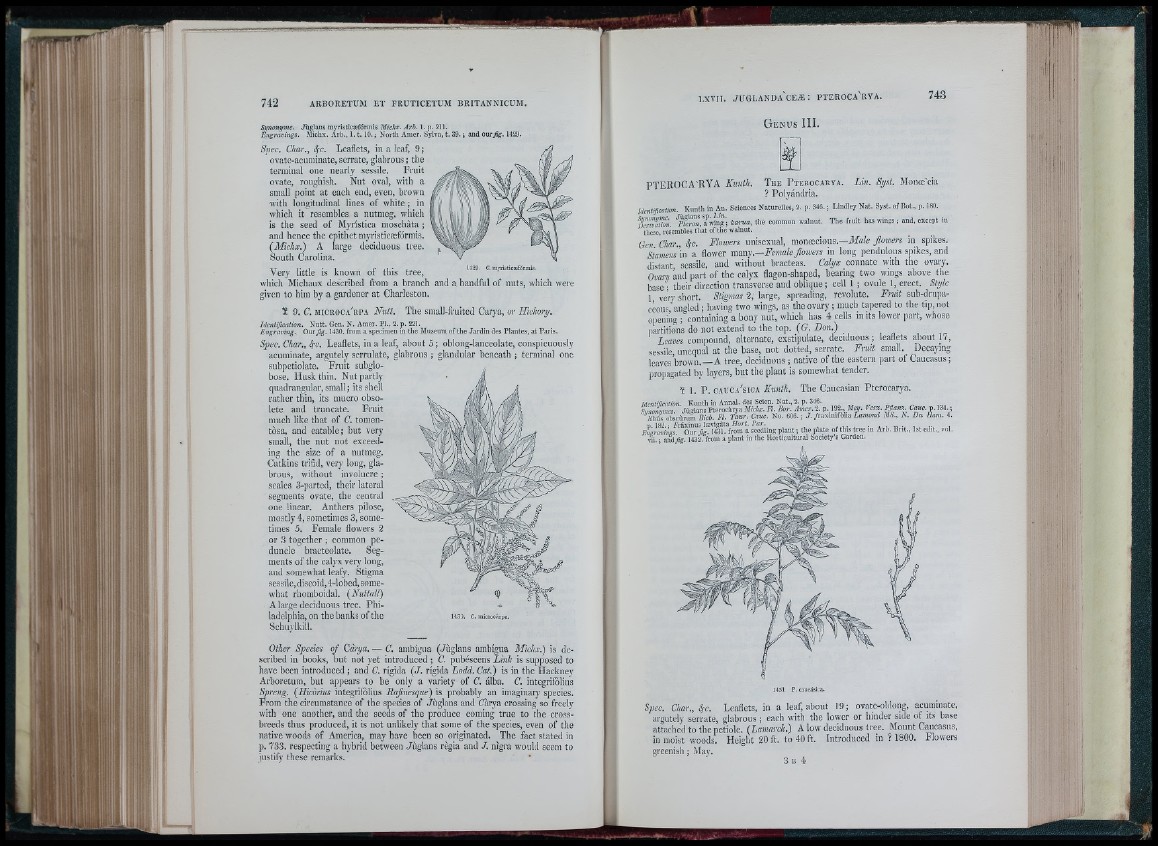
7 4 2 A R B O R E T U M E T F R U T IC E T U M B R IT A N N IC U M .
S>/nonyme. Jùglans myristicaefÓrmls Michx. Arb. 1. p. 211.
Éngravings. Michx. Arb., 1 .1. 10. ; North Amer. Sylva, t. 39. ; and o u r ^ . 1429.
Siiec. Char., Leaflets, in a leaf, 9 ;
ovate-aciiniinate, serrate, glabrous ; tbe
terminal one nearly sessile. Fruit
ovate, roughish. Nut oval, with a
small point at each end, even, brown
with longitudinal lines of white ; in
which it resembles a nutmeg, which
is the seed of Myristica rnoschata ;
and hence the epithet myristicseformis.
(Michx.) A large deciduous tree.
South Carolina.
Very little is known of this tree, ^
which Michaux described from a branch and a handful of nuts, which were
given to him by a gardener at Charleston.
¥ 9. C. m i c r o c a ' r p a N u tt The small-fruited Carya, or Hickory.
Identification. Nutt. Gen. N. Ar
Fyngraving. O mfig . 1430. from i
ler. PL, 2. p. 221.
specimen in the Museum of the Jardin des Plantes, at Paris.
Sjiec. Char., 4c. Leaflets, in a leaf, about 5 ; oblong-lanceolate, conspicuously
acuminate, argutely serrulate, glabrous ; glandular beneath ; terminal one
subpetiolate. Fruit subglobose.
Husk thin. Nut partly
quadrangular, small; its shell
rather thin, its mucro obsolete
and truncate. Fruit
much like that of C. tomentósa,
and eatable; but very
small, the nut not exceeding
the size of a nutmeg.
Catkins trifid, very long, glabrous,
without involucre ;
scales 3-parted, their lateral
segments ovate, the central
one linear. Anthers pilose,
mostly 4, sometimes 3, sometimes
5. Female flowers 2
or 3 together ; common peduncle
bracteolate. Segments
of the calyx very long,
and somewhat leafy. Stigma
sessile, discoid, 4-lobed, somewhat
rhomboidal. (Nuttall)
A large deciduous tree. Philadelphia,
on the banks of the
Schuylkill.
1439. C. microcàrpa.
Other Species of Qàrya. — C. ambigua (Jùglans ambigua Michx.) is described
in books, but not yet introduced ; C. pubescens Link is supposed to
have been introduced ; and C. rígida (J. rígida Lodd. Cat.) is in the Hackney
Arboretum, but appears to be only a variety of C. álba. C. integrifòlius
Spreng. (Hicorius integrifòlius Rafinesque) is probably an imaginary species.
From the circumstance of the species of Jùglans and Càrya crossing so freely
with one another, and the seeds of the produce coming true to the crossbreeds
thus produced, it is not unlikely that some of the species, even of the
native woods of America, may have been so originated. The fact stated in
p. 733. respecting a hybrid between Jùglans règia and J. nigra would seern to
justify these remarks.
L X V II. J U G L A N D A C E Æ : P T E R O C a T i YA.
G e n u s I I I .
7 4 3
P T E R O C A 'R Y A Kunth. T h e P t e e o c a r y a . Lin. Syst. Monoe'cia
? Polyándria.
Id en tific a tio n . Kunth In A.n. Sciences Naturelles, 2. p. 346. ; Lindley Nat. Syst. of Dot., p. 180.
H c r f iS n Kc'™», ï k i n g i karua, the common walnut. The fruit has wings ; and, except in
these, resembles that of the walnut.
Gcn Char., f r . Flowers unisexual, monoecious.—Mate flowers in spikes.
Stanien's’m a flower mam .—Female flowers in long pendulous spikes, and
distant sessile, and without bracteas. Calyx connate with the ovary.
Ooary and part of the calyx flagon-shaped, bearing two wings above the
base • their direction transverse and oblique; cell 1 ; ovule 1, erect. Style
l" very short. Stigmas 2, large, spreading, revolute. Fruit sub-drupaceous
angled ; having two wings, as the ovary ; much tapered to the tip, not
opening ; containing a bony nut, which has 4 cells in its lower part, whose
partitions do not extend to the top. (1?.
Lcaves compound, alternate, exstipulate, deciduous; leaflets about 17,
sessile unequal at the base, not dotted, serrate. Fruit small. Decaying
leaves’brown. —A tree, deciduous ; native of the eastern part of Caucasus ;
propagated by layers, but the plant is somewhat tender.
Ï 1. P. c a u c a 's io a Kunth. The Caucasian Pterocarya.
FL Bor’. Amer. 2. p. m - Meu. Ferx. V n n tt. Cauc. p. 134 ;
Ahus ohscùrdSi Bieb. FL Taur. Cauc. No. 606.; X /ra xm ifb lia £o»io>ai MS., W. D u Ham. 4.
a seedling plant ; the plate of this Uce In Arh. Brit., 1st edit., vol.
vìi. 5 am\ fig. 1432. from a plant in the Horticultural Society s Garden.
1431 p . caucásica.
Spec. Char., f r . Leaflets, in a leaf, about 19; ovate-oblong, acuminate,
argutely serrate, glabrous ; each with the lower or hinder side of its base
attached to the petiole. (Lamarck.') A low deciduous tree. Mount Caucasus,
in moist woods. Height 20 ft. to 40 ft. Introduced in ? 1800. Flowers
greenish ; May.
! ri 111 ' ■